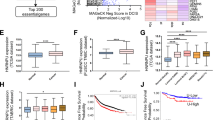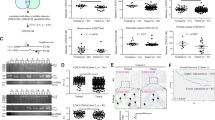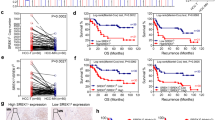Abstract
Nuclear-enriched RNA-binding proteins (RBPs) are mainly involved in transcriptional regulation, which is a critical checkpoint to tune gene diversity and expression levels. We analyzed nuclear RBPs in human HCC tissues and matched normal control tissues. Based on the gene expression levels, PTBP3 was identified as top-ranked in the nuclei of HCC cells. HCC cell lines then were transfected with siRNAs or lentiviral vectors. PTBP3 promoted HCC cell proliferation and metastasis both in vitro and in vivo. RNA immunoprecipitation (RIP), fluorescence in situ hybridization (FISH) and qRT-PCR assays verified that PTBP3 protein recruited abundant lnc-NEAT1 splicing variants (NEAT1_1 and NEAT1_2) and pre-miR-612 (precursor of miR-612) in the nucleus. NEAT1_1, NEAT1_2 and miR-612 expression levels were determined by PTBP3. Correlational analyses revealed that PTBP3 was positively correlated with NEAT1, but it was inversely correlated with miR-612 in HCC. The P53/CCND1 and AKT2/EMT pathways were determined by NEAT1 and miR-612 respectively in HCC. The PTBP3high and NEAT1high/miR-612low patients had a shorter overall survival. Therefore, nuclear-enriched RBP, PTBP3, promotes HCC cell malignant growth and metastasis by regulating the balance of splicing variants (NEAT1_1, NEAT1_2 and miR-612) in HCC.
This is a preview of subscription content, access via your institution
Access options
Subscribe to this journal
Receive 50 print issues and online access
$259.00 per year
only $5.18 per issue
Buy this article
- Purchase on Springer Link
- Instant access to full article PDF
Prices may be subject to local taxes which are calculated during checkout








Similar content being viewed by others
Change history
08 March 2023
This article has been retracted. Please see the Retraction Notice for more detail: https://doi.org/10.1038/s41388-023-02648-z
References
Ye QH, Zhu WW, Zhang JB, Qin Y, Lu M, Lin GL, et al. GOLM1 modulates EGFR/RTK cell-surface recycling to drive hepatocellular carcinoma metastasis. Cancer Cell. 2016;30:444–58.
Castello A, Fischer B, Frese CK, Horos R, Alleaume AM, Foehr S, et al. Comprehensive identification of RNA-binding domains in human cells. Mol Cell. 2016;63:696–710.
Peal L, Jambunathan N, Mahalingam R. Phylogenetic and expression analysis of RNA-binding proteins with triple RNA recognition motifs in plants. Mol Cells. 2011;31:55–64.
Lee HC, Jung SH, Hwang HJ, Kang D, De S, Dudekula DB, et al. WIG1 is crucial for AGO2-mediated ACOT7 mRNA silencing via miRNA-dependent and –independent mechanisms. Nucleic Acids Res. 2017;45:6894–910.
Köster T, Marondedze C, Meyer K, Staiger D. RNA-binding proteins revisited – the emerging Arabidopsis mRNA interactome. Trends Plant Sci. 2017;22:512–26.
Manley JL, Tacke R. SR proteins and splicing control. Genes Dev. 1996;10:1569–79.
Arslan AD, He X, Wang M, Rumschlag-Booms E, Rong L, Beck WT. A High throughput assay to identify small molecule modulators of alternative pre-mRNA splicing. J Biomol Screen. 2013;18:180–90.
Zerbe LK, Pino I, Pio R, Cosper PF, Dwyer-Nield LD, Meyer AM, et al. Relative amounts of antagonistic splicing factors, hnRNP A1 and ASF/SF2, change during neoplastic lung growth: implications for pre-mRNA processing. Mol Carcinog. 2004;41:187–96.
Ji Q, Zhang L, Liu X, Zhou L, Wang W, Han Z, et al. Long non-coding RNA MALAT1 promotes tumour growth and metastasis in colorectal cancer through binding to SFPQ and releasing oncogene PTBP2 from SFPQ/PTBP2 complex. Br J Cancer. 2014;111:736–48.
Tan LY, Whitfield P, Llorian M, Monzon-Casanova E, Diaz-Munoz MD, Turner M, et al. Generation of functionally distinct isoforms of PTBP3 by alternative splicing and translation initiation. Nucleic Acids Res. 2015;43:5586–5600.
Calabretta S, Bielli P, Passacantilli I, Pilozzi E, Fendrich V, Capurso G, et al. Modulation of PKM alternative splicing by PTBP1 promotes gemcitabine resistance in pancreatic cancer cells. Oncogene. 2016;35:2031–9.
He X, Arslan AD, Ho TT, Yuan C, Stampfer MR, Beck WT. Involvement of polypyrimidine tract-binding protein (PTBP1) in maintaining breast cancer cell growth and malignant properties. Oncogenesis. 2014;3:e84.
Cheung HC, Hai T, Zhu W, Baggerly KA, Tsavachidis S, Krahe R, et al. Splicing factors PTBP1 and PTBP2 promote proliferation and migration of glioma cell lines. Brain. 2009;132:2277–88.
Licatalosi DD, Yano M, Fak JJ, Mele A, Grabinski SE, Zhang C, et al. Ptbp2 represses adult-specific splicing to regulate the generation of neuronal precursors in the embryonic brain. Genes Dev. 2012;26:1626–42.
Zagore LL, Grabinski SE, Sweet TJ, Hannigan MM, Sramkoski RM, Li Q, et al. RNA binding protein ptbp2 is essential for male germ cell development. Mol Cell Biol. 2015;35:4030–42.
Li Q, Zheng S, Han A, Lin CH, Stoilov P, Fu XD. et al. The splicing regulator PTBP2 controls a program of embryonic splicing required for neuronal maturation. eLife. 2014;3:e01201
Bhartiya D, Scaria V. Genomic variations in non-coding RNAs: structure, function and regulation. Genomics. 2016;107:59–68.
Tsai MC, Manor O, Wan Y, Mosammaparast N, Wang JK, Lan F, et al. Long noncoding RNA as modular scaffold of histone modification complexes. Science. 2010;329:689–93.
Clemson CM, Hutchinson JN, Sara SA, Ensminger AW, Fox AH, Chess A, et al. An Architectural role for a nuclear non-coding RNA: NEAT1 RNA is essential for the structure of paraspeckles. Mol Cell. 2009;33:717–26.
Tao ZH, Wan JL, Zeng LY, Xie L, Sun HC, Qin LX, et al. miR-612 suppresses the invasive-metastatic cascade in hepatocellular carcinoma. J Exp Med. 2013;210:789–803.
Naganuma T, Hirose T. Paraspeckle formation during the biogenesis of long non-coding RNAs. RNA Biol. 2013;10:456–61.
Chakravarty D, Sboner A, Nair SS, Giannopoulou E, Li R, Hennig S, et al. The oestrogen receptor alpha-regulated lncRNA NEAT1 is a critical modulator of prostate cancer. Nat Commun. 2014;5:5383.
Idogawa M, Ohashi T, Sasaki Y, Nakase H, Tokino T. Long non-coding RNA NEAT1 is a transcriptional target of p53 and modulates p53-induced transactivation and tumor-suppressor function. Int J Cancer. 2017;140:2785–91.
Adriaens C, Standaert L, Barra J, Latil M, Verfaillie A, Kalev P, et al. P53 induces formation of NEAT1 lncRNA-containing paraspeckles that modulate replication stress response and chemosensitivity. Nat Med. 2016;22:861–8.
Choudhry H, Albukhari A, Morotti M, Haider S, Moralli D, Smythies J, et al. Tumor hypoxia induces nuclear paraspeckle formation through HIF-2α dependent transcriptional activation of NEAT1 leading to cancer cell survival. Oncogene. 2015;34:4482–90.
Imamura K, Imamachi N, Akizuki G, Kumakura M, Kawaguchi A, Nagata K, et al. Long noncoding RNA NEAT1-dependent SFPQ relocation from promoter region to paraspeckle mediates IL8 expression upon immune stimuli. Mol Cell. 2014;53:393–406.
Shen W, Liang XH, Crooke ST. Phosphorothioate oligonucleotides can displace NEAT1 RNA and form nuclear paraspeckle-like structures. Nucleic Acids Res. 2014;42:8648–62.
Tao ZH, Wan JL, Zeng LY, Xie L, Sun HC, Qin LX, et al. miR-612 suppresses the invasive-metastatic cascade in hepatocellular carcinoma. J Exp Med. 2013;210:789–803.
Lamouille S, Xu J, Derynck R. Molecular mechanisms of epithelial-mesenchymal transition. Nat Rev Mol Cell Biol. 2014;15:178–96.
Zeisberg M, Neilson EG. Biomarkers for epithelial-mesenchymal transitions. J Clin Invest. 2009;119:1429–37.
Shim JS, Matsui Y, Bhat S, Nacev BA, Xu J, Bhang HE, et al. Effect of nitroxoline on angiogenesis and growth of human bladder cancer. J Natl Cancer Inst. 2010;102:1855–73.
Pang R, Poon RT. Angiogenesis and antiangiogenic therapy in hepatocellular carcinoma. Cancer Lett. 2006;242:151–67.
Spellman R, Llorian M, Smith CW. Crossregulation and functional redundancy between the splicing regulator PTB and its paralogs nPTB and ROD1. Mol Cell. 2007;27:420–34.
Zhang L, Yang Z, Trottier J, Barbier O, Wang L. LncRNA MEG3 induces cholestatic liver injury by interaction with PTBP1 to facilitate Shp mRNA decay. Hepatology. 2017;65:604–15.
Liu X, Li D, Zhang W, Guo M, Zhan Q. Long non-coding RNA gadd7 interacts with TDP-43 and regulates Cdk6 mRNA decay. EMBO J. 2012;31:4415–27.
Chen M, Zhang J, Manley JL. Turning on a fuel switch of cancer – hnRNP proteins regulate alternative splicing of pyruvate kinase mRNA. Cancer Res. 2010;70:8977–80.
Clower CV, Chatterjee D, Wang Z, Cantley LC, Vander Heiden MG, Krainer AR. The alternative splicing repressors hnRNP A1/A2 and PTB influence pyruvate kinase isoform expression and cell metabolism. Proc Natl Acad Sci USA. 2010;107:1894–9.
Mang Y, Li L1, Ran J, Zhang S, Liu J, Li L, et al. Long noncoding RNA NEAT1 promotes cell proliferation and invasion by regulating hnRNP A2 expression in hepatocellular carcinoma cells. Onco Targets Ther. 2017;10:1003–16.
Fang L, Sun J, Pan Z, Song Y, Zhong L, Zhang Y, et al. Long non-coding RNA NEAT1 promotes hepatocellular carcinoma cell proliferation through the regulation of miR-129-5p-VCP-IκB. Am J Physiol Gastrointest Liver Physiol. 2017;313:G150–G156.
Tan HY, Wang N, Takahashi M, Feng Y, Li H, Feng Y. New natural pigment fraction isolated from saw palmetto: potential for adjuvant therapy of hepatocellular carcinoma. Int J Mol Sci. 2016;17:1277.
Acknowledgements
The authors thank Kun Liu and Huimin Wang (Department of Hepatobiliary Surgery of Xijing Hospital) for collecting the tissue samples and the follow-up information.
Authors contributions
XY, KD and HL designed the experiments and wrote the paper; SQ, LW, HZ and ZY performed bioinformatics and statistical analyses; JW, KT, ZL, ZZ and BD performed the histopathologic analyses; CX, BM, RS, XL and WL provided expression data and patient sample material. This research was supported by the National Natural Science Foundation of China (No. 81672339) and the Project of Scientific Research of Shaanxi (No. 2011KTCL03-15).
Author information
Authors and Affiliations
Corresponding authors
Ethics declarations
Conflict of interest
The authors declare that they have no conflict of interest.
Additional information
RNA Immunoprecipitation (RIP) sequencing The data were deposited in an appropriate public repository (http://pan.baidu.com/s/1boURcZ1; Security code: cprr). This is a permanent publicly accessible links. If necessary, we will upload these data to the GEO database.
This article has been retracted. Please see the retraction notice for more detail: https://doi.org/10.1038/s41388-023-02648-z"
Electronic supplementary material
About this article
Cite this article
Yang, X., Qu, S., Wang, L. et al. RETRACTED ARTICLE: PTBP3 splicing factor promotes hepatocellular carcinoma by destroying the splicing balance of NEAT1 and pre-miR-612. Oncogene 37, 6399–6413 (2018). https://doi.org/10.1038/s41388-018-0416-8
Received:
Revised:
Accepted:
Published:
Issue Date:
DOI: https://doi.org/10.1038/s41388-018-0416-8
This article is cited by
-
Long non-coding RNA SLC25A21-AS1 inhibits the development of epithelial ovarian cancer by specifically inducing PTBP3 degradation
Biomarker Research (2023)
-
NEAT1 can be a diagnostic biomarker in the breast cancer and gastric cancer patients by targeting XIST, hsa-miR-612, and MTRNR2L8: integrated RNA targetome interaction and experimental expression analysis
Genes and Environment (2022)
-
PTBP3 regulates proliferation of lung squamous cell carcinoma cells via CDC25A‐mediated cell cycle progression
Cancer Cell International (2022)
-
PTBP3 modulates P53 expression and promotes colorectal cancer cell proliferation by maintaining UBE4A mRNA stability
Cell Death & Disease (2022)
-
RNA splicing: a dual-edged sword for hepatocellular carcinoma
Medical Oncology (2022)



